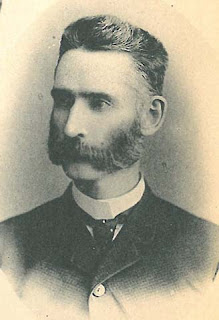Susannah "Susie" D. Smith, circa 1865. Minto Family Private Collection.
In Richard's first letter to Susie, dated July 9, 1864, he wrote:
"Respected Friend,
I suppose you will think me rather bold in addressing you in this manner but I hope you will not be offended. My object in corresponding with you is to have something to occupy my time and to relieve the monotony of camp life. ... I hope you will do me the favor to answer this poorly written letter and if you wish to keep a correspondence I will be very happy to answer your letters. Believe me, Your Sincere Friend." (Dunn Museum 93.45.433)
Richard S. Thain, circa 1885 from the History of the 96th Illinois Regiment.
Thain was the Second Brigade's postmaster and was nearly killed by a Confederate scout.
The "soldier boys" were discharged and sent home in June 1865. On June 15, while taking a break from teaching at the Grubb School near Millburn, Susie wrote of her anticipation in her diary:
"Heard Richard was in... how I do wish that I could see him. I stand at the window a moment and then take a turn in the yard hardly knowing what to do... I can write no more for the girls are crowning me with oak leaves and roses, so, as they say, that their teacher may look pretty, if she should have company this afternoon." (Dunn Museum 93.45.290)
She did have company that afternoon, and recounted the moment in her diary: "I have seen Richard, he came up to the schoolhouse... I thought that he was very kind to do so, but I could hardly speak to him, I was in such a tremble of excitement." (Dunn Museum 93.45.290)
The old Grubb School where Susie Smith taught and Richard Thain visited her on his first day back from the war. Photographed in 1966. Image courtesy of Historic Millburn Community Association.
This was probably not Richard and Susie's first meeting. They had both grown up in and around the small community of Millburn. However, their correspondence most certainly changed the dynamic of that relationship. Several days later, Susie wrote that she had spent "the happiest day of my life" in Richard's company, singing and talking.
Despite their age difference, Susie was Thain's senior by six years, they spent the next year and a half together. Richard was often in Susie's company at church meetings, and spent evenings at the Smith family home.
Smith family home, north of Millburn on Miller Road. Photo circa 1890. (Dunn Museum 93.45.79).
In early fall 1865, Richard moved to Chicago to start in business, but continued to make frequent visits to Millburn. On April 13, 1866, Susie wrote: "After tea, looked out and saw Richard coming up the path, quite a joyful surprise. R staid at our house all night."
Their relationship continued until December 1866, when things noticeably changed. Susie received fewer letters and still fewer visits from Richard. On Christmas Day, she wrote:
"Christmas... Had a good time and yet there is such a blank when R is gone that I cannot enjoy my self as well. How strange it seems that one person can add so much to anothers happiness and become as it were a part of anothers existence. It seems as though the greatest happiness I have next to the knowledge of the love of God is the thought of the love of my Richard thoughts of him are ever in my mind."
And then Susie's heartbreaking entry for January 1, 1867: "Happy New Year was exchanged on every side, and we passed a very pleasant day and evening... When we reached home my disappointed heart which I had managed to keep down all day gave way and I had a hard cry. I did hope to see Richard to day and I know he would have come if it had been possible but I was so grieved over it seemed impossible to keep from crying. And so I did cry. May God forgive me for being so weak. When will I ever learn to control myself. Ned dear brother came and put his arms around me and tried to comfort me." (Dunn Museum 93.45.290)
Susie's diary ends on January 17th, leaving us with many questions, but from her tears we know she was not ready to lose Richard.
There is a happy ending for Susie, but it does not involve Richard Thain. He spent a couple of years traveling cross-country and building his business before settling down with Hannah Abbott in 1869 in Oak Park, Illinois. After Hannah's death, he married Emma Jenness in 1881.
In 1868, one year after the end of her romance with Richard, Susie began co-editing the Millburn Literary Association's publication with her neighbor, David J. Minto. They had been attending the same prayer meetings and evenings of singing at Mr. Hughes's for two years, and were both teachers.
David J. Minto, circa 1870. (Dunn Museum 93.45.52) David enlisted with the 96th Illinois, and was honorably discharged due to illness in April 1863. On his return to Millburn, he farmed his family's land, and taught in the local schools.
In the same letter, Susie wrote: "Don't you think Davie that the 20th would be a good day for... you know." That "you know" referred to a possible wedding day. Indeed, they were married on that very May 20th by Rev. Thomas Lightbody of the Millburn Congregational Church, and remained married for 44 years.
Photographed in 1898 at the Minto family homestead are Susie and David Minto (seated) with their only surviving children, David Harold and Una (with kittens). (Dunn Museum 93.45.91)
Susie and David's granddaughters, Katherine and Lura, donated the family's letters and diaries to the museum in 1993. The museum's Minto Collection is hosted online by the Illinois Digital Archives.
























